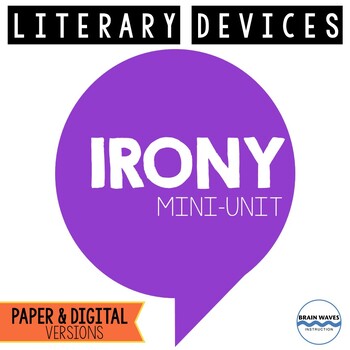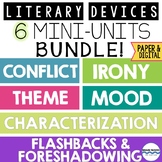Irony Mini-Unit - Lessons on Situational, Dramatic, & Verbal Irony (Google)
- PDF
- Google Apps™

What educators are saying
Also included in
- This bundle includes three 3-day mini-units on Mood, Foreshadowing & Flashbacks, and Irony!Great News! The student packets in each mini-unit are also available as a Google Slides resources. In addition to the PDF version, students can complete the packet pages via a file sharing service such asPrice $14.99Original Price $16.47Save $1.48
- Save BIG with this bundle of LITERARY DEVICES mini-units --- Theme, Conflict, Characterization, Irony, Mood, Flashbacks and Foreshadowing!This bundle includes SIX 3-day mini-units!Great News! The student packet in each mini-unit is also available as a Google Slides resource for students. In additionPrice $27.99Original Price $32.94Save $4.95
- Great news! Your entire month of ELA instruction is already planned for you! This bundle includes 5 print-and-teach units that you can teach during the entire month of February! That’s right! Just download these units and you won’t have to do a bit of lesson planning! This bundle includes fivePrice $26.99Original Price $31.45Save $4.46
Description
Help students develop a deep understanding of situational, dramatic, and verbal irony with this fun and engaging 3-day mini-unit!
This IRONY MINI-UNIT provides numerous opportunities for students to learn about the three types of irony, determine the purpose of irony, analyze irony, describe how irony contributes to a story and even write their own examples of irony. Each lesson starts with a fun and engaging activity – Irony Hunt (where students differentiate between examples of irony and just bad luck while rotating around the classroom), Types of Irony – Tri-Fold Cards (where students create interactive cards for the types of irony that they flip in response to ironic situations), and Irony Flip Cards (where students create interactive flip shapes, create irony, and then explain it). Then, students learn about and practice understanding irony through whole group instruction, small group work, partnerships, and independent practice.
In this mini-unit, students will develop a deep understanding of literary devices, situational, dramatic, and verbal irony. Students will complete guided notes, reading comprehension passages, graphic organizers and writing activities. In addition, they’ll practice identifying irony while reading short and long reading passages. This is a fun unit for students and teachers!
Great News! The student packet is also available as a Google Slides resource for students. In addition to the PDF version, students can complete the packet pages via a file sharing service such as Google Drive, Google Classroom, or in the internet “cloud.” The digital version of the packet is accessible from any computer and allows students to complete their work online.
* FYI: The anticipatory set activities that accompany each lesson are NOT in a digital format. They will still need to be printed for students due to the hands-on and interactive nature of the activities.
This detailed IRONY mini-unit includes:
• 3 Detailed Daily Lesson Plans
• Irony Hunt Tracking Sheet
• 10 Irony Hunt Task Cards
• Irony Clues (for teacher read aloud)
• Types of Irony Tri-Fold Cards
• Irony Flip Cards (with sentence starters)
• Irony Flip Cards (with blanks)
• Irony Explanation Templates
• Literary Devices and Irony Guided Notes
• Three Practice Reading Passages with Comprehension Questions
• Finish the Story – Writing Activity
• Types of Irony Guided Notes
• Make it Ironic Activity
• Irony Types Partner Activity
• Breaking News – Irony Headlines and Analysis
• Long Reading Passage and Reading Comprehension Questions
• All keys for student work and instruction
FYI: This unit is also a part of a Literary Devices Bundle. The bundle is filled with 6 fun mini-units to teach literary devices! You can check it out HERE.
You may also like…
• This or That Daily ELA Warm-Ups
• Emergency Substitute Plans - Absolutely no copies needed!
Following is Fun!
Get the inside scoop on all store discounts, free products, and product launches. Just click the green “Follow Me” star under my store name on this page or click the green “Follow Me” star on my store homepage.
Let’s Stay in Touch!
*** Click HERE to receive the Brain Waves Instruction Newsletter filled with exclusive FREEBIES and Teaching Tips!
Thanks!
Brain Waves Instruction








